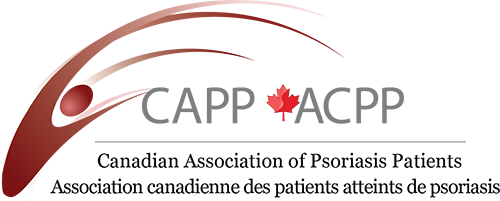What is it?
Psoriasis (pronounced so-RYE-a-sis) is a persistent chronic inflammatory condition that affects approximately 1 million Canadians. Psoriasis severity ranges from a few dandruff-like scales to widespread patches that cover large areas of skin. Psoriasis may flare up then go into remission. During flare-ups, psoriasis causes itchiness and pain in the inflamed skin.
Psoriasis affects the regeneration of skin cells. In psoriasis, overactive signals in the body's immune system trigger new skin cells to form in three to four days instead of the usual cycle that takes 28 to 30 days. Because skin cells grow too quickly, they pile up on the skin surface creating painful and itchy red lesions called plaques, which can form silvery scales.
Psoriasis most commonly affects the elbows, knees and scalp, but can also occur on the palms of the hands, soles of the feet, nails, genitals and torso.
There is currently no cure for psoriasis, but treatment can interrupt the psoriasis cycle and significantly relieve its symptoms and appearance.
Fast facts about psoriasis:
- Psoriasis often begins between the ages of 15 and 25, but it can happen at any age. There is a second smaller incidence peak between the ages of 50 and 60.
- Psoriasis affects men and women nearly equally.
- Psoriasis is not contagious and cannot be spread from one person to another.
- Psoriasis affects people of all sexes, races and ethnic groups.
- Outbreaks may come and go, but psoriasis is a chronic condition that can be managed but not cured.
- About 2% to 3% of the world’s population has psoriasis.
- Nearly 60% of people with psoriasis report that psoriasis is a problem in daily life.
- About 30% of people who have psoriasis will develop psoriatic arthritis, a type of inflammatory arthritis.
- About 60% of people with psoriasis miss an average of 26 days of work each year because of their condition.
- One of every three people with psoriasis has a family member with psoriasis.
The 5 types of psoriasis
There are five main types of psoriasis. Usually, only one type of psoriasis appears at a time, but some people can get different types at the same time. Sometimes, after one type of psoriasis clears, another type appears. One type of psoriasis may transform into another after exposure to a trigger, such as stopping certain psoriasis medications abruptly.
| |
Type
|
Details
|
| |
Plaque
|
- Most common type of psoriasis: 80-90% of people with psoriasis.
- Sharply outlined, swollen, dry, red, itchy, painful skin lesions (called plaques) with silvery scales on top, 1-10cm in size.
- Most often on the scalp, torso, buttocks, elbows and knees. Also appear on genitals, lower back, palms of hands, soles of feet and inside the mouth.
- Generally symmetrical – in other words, it appears on both sides of the body.
- Frequently has nail involvement
- Lesions may crack and bleed
- Swollen skin at joint lines or on the palms may also occur.
|
| |
Guttate
|
- Second most common type of psoriasis: 10% of people with psoriasis.
- Distinct, small (1-10 mm), droplet-shaped, red spots, often >100 lesions, usually appear on the torso, arms and legs and sometimes on the scalp, ears and face. A fine scale covers the spots.
- Starts suddenly. Often triggered by a bacterial infection such as strep throat or tonsillitis, skin injuries, stress or certain medications.
- Sometimes followed by plaque psoriasis, or it can be an exacerbation of plaque psoriasis
- More common in children and adults under 30
|
| |
Inverse (flexural)
|
- Located in skin folds and on sensitive skin: armpits, groin, under the breasts, between the buttocks and around the genitals.
- Smooth, shiny patches of very red skin.
- Common in people with deep skin folds.
- It can occur on its own but usually appears along with plaque psoriasis.
- Easily worsened by rubbing and sweating.
|
| |
Pustular
|
- Rare and can be severe.
- Occurs in two forms:
- localized palmoplantar pustulosis (PPP), affecting the palms of the hands and soles of the feet, and
- generalized pustular psoriasis (GPP), which affects large areas of the body.
- Occurs rapidly. Skin gets red and tender, then white pus-filled blisters erupt a few hours later. Blisters dry up, forming scales, in a few days, but tend to go in a cycle, reappearing every few days or weeks.
- People with widespread patches of GPP need to go to the hospital for treatment as it can be life-threatening.
- GPP can cause fever, chills, severe itchiness, dehydration, rapid pulse, anemia, exhaustion, weight loss and muscle weakness.
- Triggers include infections, stress, certain medications, injury to the skin, cold weather, metal allergies, smoking and heavy alcohol consumption.
|
| |
Erythrodermic (exfoliative)
|
- Least common and most severe type: 1-2%
- May be life-threatening and require hospitalization.
- Red, scaly, peeling lesions cover over 80% of the body, including eyes, lining of the mouth and inside of the nose.
- Can itch and burn intensely. The skin swells and sheds multiple layers, often in large sheets.
- More common in men than in women
- May happen gradually in a person with unstable plaque psoriasis or suddenly in someone who has never had psoriasis.
- Can be triggered by severe sunburn, underlying cancer, corticosteroids and other medications, infection, alcohol, drug-induced allergic rashes, and abrupt withdrawal of systemic medication
- Loss of large areas of skin and may lead to severe illness, such as infection, pneumonia, congestive heart failure and cause problems with maintaining normal body temperature and fluid levels. Fever is common.
|






